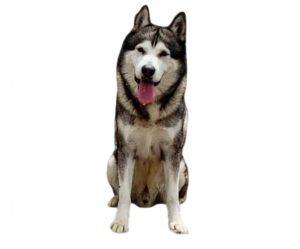
We Tried 5 Fresh Dog Food Brands
Is all the marketing hype worth it? Did our dogs enjoy them? Here’s our dogs’ totally honest review.
Particularly appreciated as a sled dog for his power and great endurance, but slower than others in his class, the Alaskan Malamute is today essentially a companion or show dog.
The Alaskan Malamute is no different from all Nordic dogs. Of a rather independent nature, he will have to be trained accordingly to prevent him from becoming the leader of the pack.
Patient with children and a good player, this is not always the case with other dogs. Intelligent and receptive to education, the Alaskan Malamute is easy to educate but his tendency to dominate must be adequately controlled.
He can live anywhere as long as he benefits from his vital space for his exercise. Like all Nordic dogs, he's the natural leader of the pack. Independent and not very docile, he needs a firm and early education where the master or family leader imposes himself as leader of the pack.


Powerful, solid, strong and muscular, the Alaskan Malamute has a robust and exceptional construction. His strong bones and very powerful muscles make him an outstanding working dog. Even if his fur makes him look like a "teddy bear", his physique and silhouette make him a dog of exceptional endurance.
Between 61 and 66 cm (24.02 to 25.98 inches) for the male
Between 56 and 61 cm (22.05 to 24.02 inches) for the female
Between 36 and 43 kg (79.37 to 94.80 pounds) for the male
Between 32 and 38 kg (70.55 to 83.77 pounds) for the female
The coat may be any colour from grey to black, but white must be present on the legs and feet as well as on the lower part of the body. The white parts of the head must be symmetrical but may present a varied pattern.
His rough, thick coat is medium length and he has a very dense undercoat.
According to the FCI breeds nomenclature, this breed belongs to group 5, section 1 and is #243
Does this dog suit your lifestyle?
Every dog breed has its own characteristics. However, the actual character of a dog can vary from one to another within the same breed.
Find out if the Alaskan Malamute is your ideal dog breed with our quiz.
That will take you less than 3 minutes!
Take the quizAs it is vital for the Alaskan Malamute to spend his excess energy, more sedentary masters may not be recommended in his case unless he has a large fenced garden or a farm with a large plot of land where he can have fun and run freely without danger.
However, we must not forget that the Alaskan Malamute has a predatory instinct that can sometimes harm the animals of the farm if in presence of chickens, ducks or any other animals that he considers pray. His natural instincts easily take over in such situations.
This large, hardy dog is very robust and almost never sick. He generally enjoys excellent health and a long lifespan. He can withstand very cold temperatures and bad weather and even though he is not afraid of heat, he needs to have a place in the shade in summer as well as a large bowl of water to avoid dehydration.
GROOMING
His dense and thick coat requires a good regular brushing. Moulting periods are intense because he sheds a large amount of hair during these times and brushing becomes essential. Apart from brushing, no other maintenance is necessary in his case.
The Alaskan Malamute name comes from a tribe of Indians from Northern Alaska in the high hostile regions, the Mahlemuts. Living in these remote and very hostile regions, the survival of the people of the tribe depended greatly on their dogs on which they relied for hunting, work and transport of food or other essential needs.
Weather resistant and of great strength, the dogs were treated with respect and very well cared for. The Alaskan Malamute was extremely important and was considered a full member of the tribe.
The Alaskan Malamute is therefore native to Alaska as his name suggests. This breed is one of the oldest breeds of sled dogs in the Arctic. There were some attempts to crossbreed him that failed for several reasons.
In the 19th century, Canadians and Americans located in Alaska used the Malamute to transport the mail at the time. The Americans created the first club of the breed in 1935 that was recognized by the American Kennel Club the same year.
He arrived in France only in 1960 where his first breeding began in 1975.
The Alaskan Malamute remains above all an exceptional sled dog for whom work has no end. It is also from his endurance and great tenacity at work that he gets his well-deserved nickname of "snow locomotive".
Sled dog work being no longer relevant today, the Alaskan Malamute has been dethroned by faster Nordic dogs in races and speed events that require faster and more agile dogs than him.
He has thus become, over time, a superb show dog and an excellent life companion. Even if some considerations are to be taken to own such a dog, the Alaskan Malamute has all the qualities necessary to bring happiness to many owners and for many years to come.

Is all the marketing hype worth it? Did our dogs enjoy them? Here’s our dogs’ totally honest review.